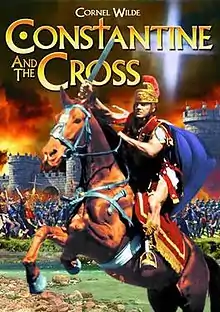Constantine and the Cross
Constantine and the Cross (Italian: Costantino il grande) is a 1961 historical drama film about the early career of the emperor Constantine, who first legalized and then adopted Christianity in the early 4th century. The fictionalised film only stretches as far into his life as the Battle of the Milvian Bridge in AD 312.
| Constantine and the Cross | |
|---|---|
 | |
| Directed by | Lionello De Felice |
| Produced by | Mino Loy Luciano Martino |
| Written by | Lionello De Felice Michael Audley (English dialogue) |
| Starring | Cornel Wilde Belinda Lee Massimo Serato |
| Music by | Mario Nascimbene |
| Cinematography | Massimo Dallamano |
| Distributed by | Embassy Pictures (USA) |
Release date | 1961 1963 (US) |
Running time | 120 min |
| Country | Italy Yugoslavia |
It was also known as Constantine the Great or Constantino il Grande - In Hoc Signo Vinces.[1]
Premise
Constantine wins a battle and is sent to Rome. One the way he and his friend Hadrian are attacked by bandits. Hadrian is nursed back to health by some Christians, including Livia. The bandits were sent by Maxentius, Constantine's rival for power.
Constantine watches some Christians be eaten by the lions. He jumps into the arena to defend a surviving child, and asks for the other Christians to be set free.
Livia is arrested. Hadrian, who has fallen in love with her, arranges for her to escape from prison. Constantine is blamed, Maxentius persecutes Christians and attacks Constantine in Gaul.
Cast
- Cornel Wilde as Constantine
- Belinda Lee as Fausta
- Massimo Serato as Maxentius
- Christine Kaufmann as Livia
- Fausto Tozzi as Hadrian
- Tino Carraro as Maximian
- Carlo Ninchi as Constantius Chlorus
- Vittorio Sanipoli as Apuleius
- Nando Gazzolo as Licinius
- Annibale Ninchi as Galarius
- Elisa Cegani as Elena
- Franco Fantasia as Roman Soldier
- Loris Gizzi as Roman Prosecutor
- Enrico Glori as Livia's Father
- Jole Mauro as Celi
- Nando Tamberlani as Diocletian
- Renato Terra as Jailer
- Lauro Gazzolo as Amodius
Production
Filming took place in August 1960, with locations in Yugoslavia and studio work in Rome.[2] While filming a scene in Rome Cornel Wilde was scratched by a lion.[3] Filming was completed by November.[4]
Reception
The New York Times called it "one of those ponderous costumed tabloids that's trampled history to death and turned what's left of its fragments into boring banalities."[5]
The Monthly Film Bulletin said "the familiar ingredients of this tired spectacle - lions, fair haired Christian girls, torture chambers, battles, assassination attempts, intrigue - fail to arouse any noticeable excitement in the director or the cast."[1]
The movie was one of Belinda Lee's more widely seen European films.[6]
See also
- List of historical drama films
- List of films set in ancient Rome
References
- CONSTANTINE THE GREAT "(Costantino Il Grande - In Hoc Signo Vinces)" Monthly Film Bulletin; London Vol. 29, Iss. 336, (Jan 1, 1962): 153.
- This Hose for Exhibition With 36 others Bristow, Winifred. Picture Show; London (Aug 27, 1960): 3-4.
- Wilde Scratched by Lion New York Times 1 Sep 1960: 30.
- "Rome". Variety. 16 November 1960. p. 77.
- The Screen: 'Constantine' Tramples History to Death The Cast By BOSLEY CROWTHER Special to The New York Times 14 Mar 1963: 8.
- Vagg, Stephen (September 7, 2020). "A Tale of Two Blondes: Diana Dors and Belinda Lee". Filmink.
External links
| Wikiquote has quotations related to: Constantine and the Cross |
- Constantine and the Cross is available for free download at the Internet Archive
- Constantine and the Cross at IMDb
- Constantine and the Cross at the TCM Movie Database
- [COSTANTINO IL GRANDE - IN HOC SIGNO VINCES
- Constantine and the Cross at Letterbox DVD